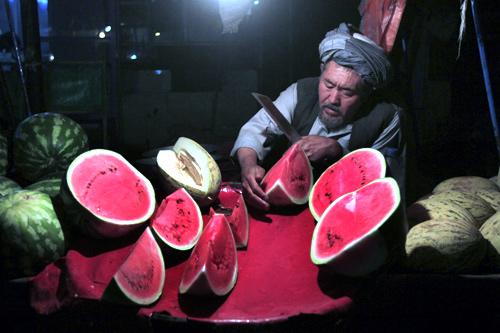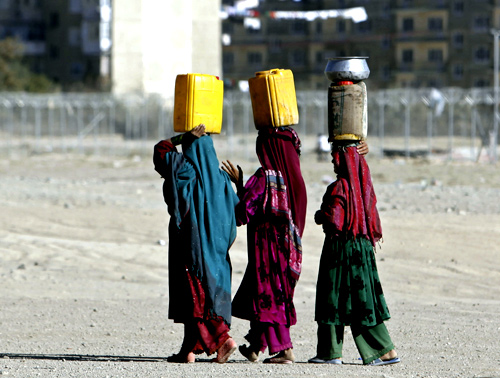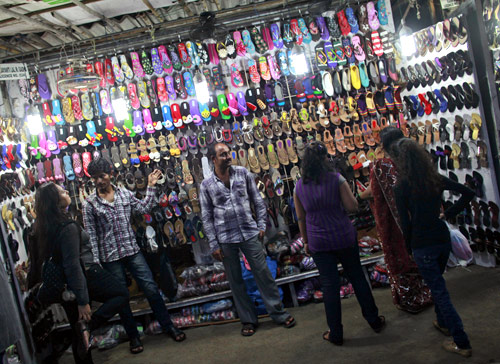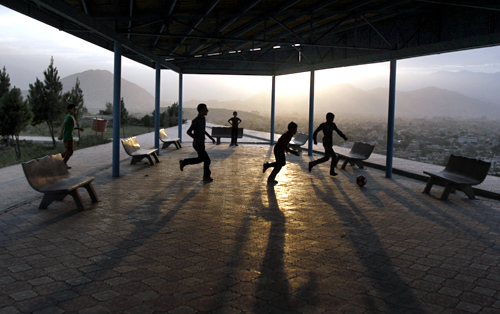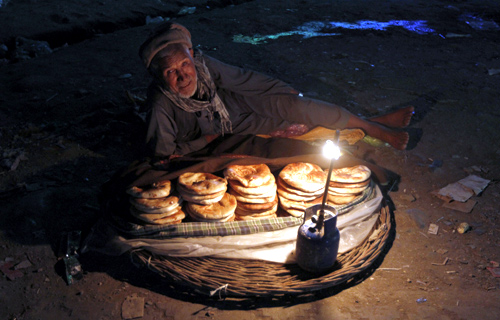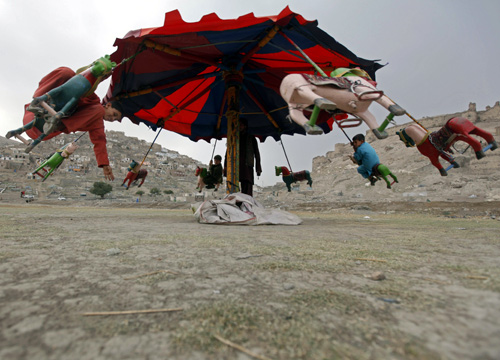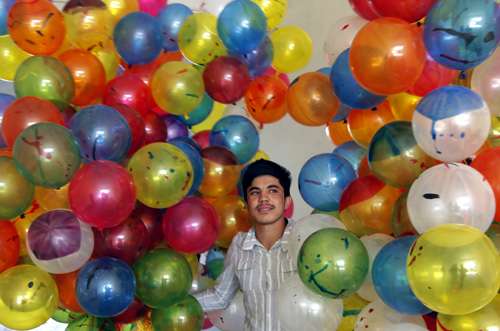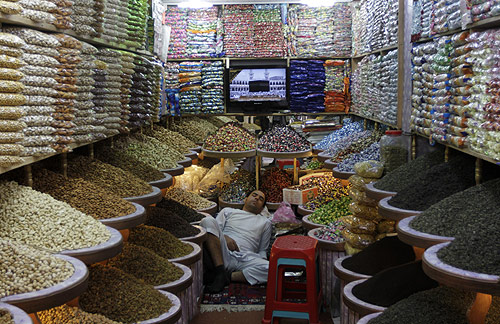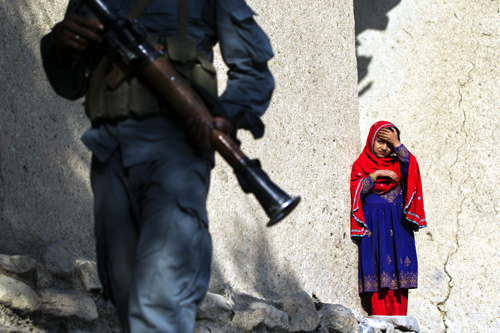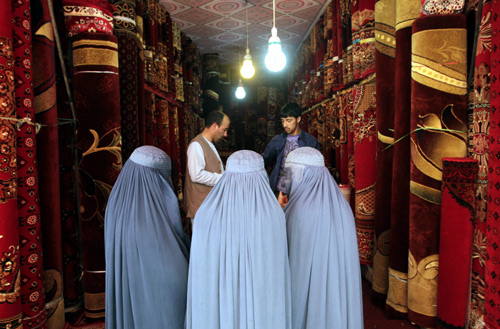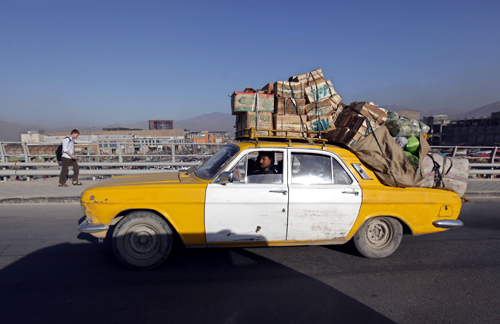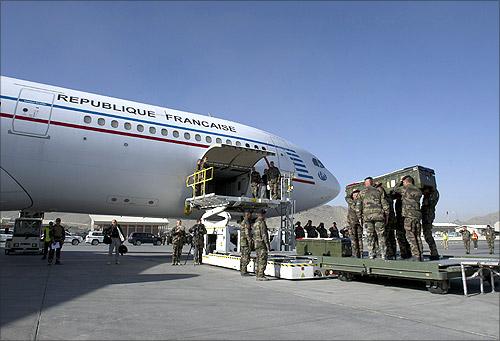 | « Back to article | Print this article |
A thriving economy of Afghan business in Delhi!
Every day, Ariana Afghan Airlines, Safi Airways, Kam Air, SpiceJet and Air India bring as many as 650 Afghans to New Delhi's Indira Gandhi International Airport from Kabul - students, traders, asylum seekers, tourists and, most of all, patients looking for treatment that is not available in their country.
Once the winter sets in, and the Delhi weather becomes more amenable to the Afghans, this number will rise to 2,000.
Such is the rush for seats that flying to Kabul (it fetches Rs 9 per kilometre per seat) has become more profitable for airlines than flying to London, Singapore or Dubai (Rs 4 each).
As a result, there is a community of Afghans taking shape in Delhi, around which has sprung a small but thriving economy.
Click NEXT to read more...
A thriving economy of Afghan business in Delhi!
The United Nations High Commission for Refugees (UNHCR) reckons there are 9,000 Afghan residents in Delhi and its suburbs (which are home to over 10 million people) - 90 per cent of these are Hindus and Sikhs who began to move to India in small batches after the 1979 Soviet invasion of Afghanistan and in larger groups after the Taliban came to power in 1996.
But there is an even larger floating population that comes for a few days, weeks or months. The Indian embassy in Kabul issued 65,000 visas last year.
After he lands at the airport, an Afghan's fate in the city is in the hands of the tarjuman, literally a Dari-English-Hindi (Dari, a variant of Persian, is spoken by almost half of Afghanistan) translator but also a guide, confidant and facilitator.
Hiring a tarjuman can cost him Rs 500 a day. (The tips at the end of the assignment, before the visitor boards the flight back to Kabul, can be as high as Rs 10,000.)
Click NEXT to read more...
A thriving economy of Afghan business in Delhi!
In his blue checked shirt and fitted jeans, Haroon, 40, has the air of a seasoned tarjuman.
He came to India barely a year ago and has picked up a smattering of Hindi and English, but that's good enough for him to be in business. In fact, he operates at the top end of the market. "I deal with only the VIP category - mainly patients - for Rs 1,000 a day."
And then there's his other "job". Located off a bustling street frequented by Afghans, Haroon's office in South Delhi's Lajpat Nagar is a cubby hole with dark-blue walls, shaded by a tree that blocks its signage: FRRO Registration.
This is just one of the many local counters where facilitators help Afghan nationals register online with FRRO, or the Foreign Regional Registration Office, on their arrival in India for a fee of Rs 100-150.
Click NEXT to read more...
A thriving economy of Afghan business in Delhi!
"Every day our office helps as many as 30 to 40 Afghans register with the FRRO," says Haroon. There are hundreds of tarjuman in Delhi.
Freelancers such as Haroon have competition these days. Dheerendra Singh Tomar, 38, a Mumbai lad who relocated to Delhi in 2006, was quick to sense the opportunity.
He has raised a corps of 50 translators, called Afghan Helpline, who receive the Afghan at the airport, help him find accommodation, show him around, and also see him off.
"Since I had heard that some translators were fleecing international patients, I decided to bring a few trusted interpreters under one umbrella and let them work after due identity checks," says he.
Tomar has priced his services too at Rs 500 a day - the same as a freelance tarjuman. If all his translators are engaged, Tomar's venture can yield Rs 25,000 a day, Rs 7.5 lakh a month and Rs 90 lakh a year.
Click NEXT to read more...
A thriving economy of Afghan business in Delhi!
But his agency has begun to hit the freelancers - mostly displaced Hindus and Sikhs. "I often get intimidating calls from some translators, who feel threatened by the transparency I'm trying to bring into the business," says Tomar.
He hasn't stopped with Afghan Helpli#8800 he also manages CureMax, a month-old medical tourism company that runs a swanky multi-specialty clinic tucked away in a basement on Delhi's Siri Fort Road. Most of his patients, of course, are Afghans.
What Tomar does on a modest scale, larger hospitals are doing in grand style. At Indraprastha Apollo Hospital, 30,000 international patients came for treatment in 2011, of which 36 per cent, or over a third, were Afghans.
According to a spokesperson of the hospital, most Afghans come to the oncology, cardiology and orthopedic departments.
Click NEXT to read more...
A thriving economy of Afghan business in Delhi!
Other South Delhi hospitals such as Max Devki Devi have also gained from the influx of Afghan patients.
These hospitals, thus, have dedicated desks for Afghans, free translation services, and even information centres in Kabul. The chemists aren't far behind. In South Delhi markets, drug stores with bright green and red signs in Dari have sprung up along bustling lanes.
"They buy medicine in bulk for three or six months, till they come back again for treatment. They have been coming in such great numbers that I've picked up Dari from them," says a chemist in Lajpat Nagar, who also stocks Olay beauty products, which finds more customers among Afghan men than women.
Click NEXT to read more...
A thriving economy of Afghan business in Delhi!
The flood of Afghan medical tourists has also meant a thriving rental accommodation business.
Ironically, in Hindu- and Sikh-dominated South Delhi, where most homeowners are wary of renting their property to local Muslims, the Afghans face hardly any problem.
On a muggy Sunday morning in Hauz Rani - a village in South Delhi overlooking Max Devki Devi Hospital - a sleepy-eyed Afghan tarjuman in floor-sweeping pajamas sloshes his way through a sludge-covered narrow lane squeezed between several tall tumbledown houses.
He stops outside a three-storey house and cranes his neck to peep through its slightly open front door. A salwar suit-clad woman swings the door open, gives him a knowing look, and leads the way to an apartment inside.
"[It's available for] Rs 900 a day, with geyser and TV, electricity extra," she says. It's a two-room apartment, painted in tacky green, with a kitchen off the main bedroom and a bathroom.
Click NEXT to read more...
A thriving economy of Afghan business in Delhi!
Another two-bedroom apartment in the locality is getting a makeover. Inside an en suite bedroom, wires dangle from the ceiling; below, on a floor strewn with wood chips, sits a bed on which lies a dusty fan.
"(It's for) Rs 1,200 a day; there's woodwork, a TV, AC, kitchen. It will be rent-ready in one day," informs an Indian facilitator who also runs a grocery in Hauz Rani.
"This shopkeeper will get a cut of at least Rs 300. During winter months [when the trickle of Afghans becomes a flood], a decent apartment worth Rs 1,500 a day costs Rs 3,000. Let's walk further. I'll show you more, better houses," says Amin Ibrahim, a 20-year-old Afghan from Mazar-i-Sharif, the fourth-largest city of Afghanistan.
This is Ibrahim's sixth visit to India; since 2009, he has flown to India for his gastroenterology treatment, has accompanied his mother for her orthopedic surgery, his elder brother for neurological treatment, and is again visiting for his brother's aesthetic surgery.
Click NEXT to read more...
A thriving economy of Afghan business in Delhi!
On Saturday evening, a hesitant Ibrahim had agreed to be part of a house-hunting expedition the next day and was badgered into posing as spouse.
His preliminary advice: "Wear a kurta, not too short, not too long, hair tied up, wrap a dupatta around your head, put on a pair of jeans, avoid eye contact, and conceal your pimples. You could pass yourself off as an Afghan woman in Delhi. Just do not speak - that will give the game away."
The steady stream of Afghans in the national capital has also spawned a burgeoning restaurant scene, but mildly-spiced food geared to the Afghan palate is not the only thing that brings newly-arrived Afghans to these eateries.
"Our restaurant is a one-stop shop. Many Afghan patients carrying luggage head here straight from the airport. We get people to help them with accommodation, hospitals and translation," says Ismail Pirzada, who runs Kabul Delhi restaurant in Lajpat Nagar. Ninety per cent of Pirzada's customers are Afghans, most of whom are patients
looking for a taste of home.
Click NEXT to read more...
A thriving economy of Afghan business in Delhi!
You can feast on a meal of Qabli Pulao (long-grained steamed rice containing mounds of lamb or chicken and garnished with julienned carrot, raisins, almonds and pistachios), manto (steamed dumplings stuffed with mutton and onions), borani banjan (eggplant) et cetera here for Rs 300-400.
No Afghan meal is, however, complete without bread, or naan. "During peak season, we sell 1,000 naans a day," reveals Sarvar, 40, over a cup of piping-hot chai sabz (green tea), as he squats on a red rug spread out on a platform inside his cave-like shop on Bhogal's Central Road.
From five in the morning till well past midnight, five men and a scalding clay tandoor churn out loaves of bread from fermented wheat flour - naan gerda (round), naan khasa (oval), roghani (slightly greasy) - which sell briskly at Rs 10 apiece.
Click NEXT to read more...
A thriving economy of Afghan business in Delhi!
As evening wears on, a multitude of Afghan refugees, mostly hired as salespersons and translators, throng the many Afghan restaurants and bakeries that have come up along Central Road, a vibrant replica of a Kabul street.
Away from the hustle of the marketplace and further down the street, a red hoarding reads: Learning Academy. Inside a basement, across at least five rooms, Prawal Mani Tripathi's finishing school offers Afghans lessons in English for Rs 500-1,000.
"The current batch comprises 40 Afghan students. After October 15, this number will go up to 70," says Tripathi, 30, a fast-talking Bihari who set up this academy last year.
"All my students, whether Indians or Afghans, are required to give presentations from time to time on Mahatma Gandhi," says Tripathi.
No wonder, then, that his classes give lessons in much more than English - discussions among Afghan and Indian students on polygamy, ethnic strife, the Kashmir issue and suchlike make for a unique melting pot.
"Once an Afghan man, accompanied by his burqa-clad wife, demanded that he be allowed to sit in class while she learns English and that there would be no eye contact," says he. "I rejected the first condition; accepted the second. She completed her course in three months."
Click NEXT to read more...
A thriving economy of Afghan business in Delhi!
For some women, Delhi provides an escape from conservative Afghanistan.
"They respect women here and no one cares what you wear, at least here in Delhi," says Majooba Suresh, 28, who's dressed in a natty pink top and slim-fit denim trousers.
This is ironical since Delhi is infamous for being the most unsafe place in India for women.
A former Oxfam gender manager in Afghanistan's northeastern province of Badakhshan, she has come to India for dental treatment, accompanied by her husband and two children.
A few short steps away from Suresh's squeaky-clean apartment in Lajpat Nagar, painted a pleasing pink, stands a glass-fronted cosmetic store with clinical white walls.
Click NEXT to read more...
A thriving economy of Afghan business in Delhi!
Inside, Freba, 25, hair swept back in a ponytail, is neatly arranging beauty products on a glass shelf.
For someone who fled her country a year ago with a younger brother and five-year-old daughter to escape a divorced husband's unrelenting efforts to gain custody of their only child, Freba is reasonably settled in her new life.
A native of Wazir Akbar Khan, an affluent neighbourhood in northern Kabul, she is registered as an asylum seeker with UNHCR and gets by on a salary of Rs 12,000 per month.
Ask her how she's coping and Freba comes alive. "Ye ab ghar hai; azaad lagta hai" (This is home now; it feels free), she beams in pidgin Hindi, looking out the glass door.
Some names have been changed on request
